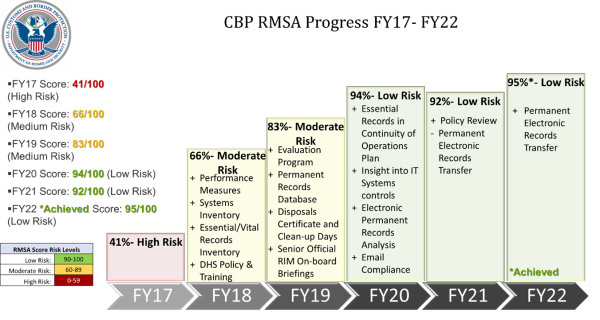
The protection of public information and records is of the utmost importance in the digital age. With the ever-increasing number of cyber threats, it is imperative that government agencies take ensure the safety and security of data. U.S. Customs and Border Protection (CBP) is committed to providing full transparency by dedicating resources to improve how public information and records are protected. The CBP Records and Information Management program ensures the public has access to information created, stored, shared, and utilized in support of the CBP mission.
In a single day, CBP processes over 800,000 passengers and pedestrians traveling across our borders via truck, rail, sea, air, land, and seaports of entry. Additionally, CBP seizes 2,895 pounds of drugs, $217,700 of illicit currency, and $8 million worth of products with intellectual property rights violations. While these figures represent just a fraction of the transactions and interactions of the CBP workforce on a typical day, each of these transactions generate thousands of records and documents.
CBP has committed considerable time and resources over the past four years to improve how public information and records are protected. At the same time, CBP is devoted to making records accessible for research and reference via the Freedom of Information Act request process and proper archiving of permanent records to the National Archive where they are preserved and available as a lasting part of American history. The results of these efforts have been impressive and resulted in a 54% increase in governance posture compliance.
The CBP Records Management program was built and enhanced over the past four years to ensure compliance with the statutes, laws, policies, directives, executive orders, and regulations such as the Federal Records Act (44 USC) and 36 Code of Federal Regulations. The National Archives and Records Administration (NARA) is the official oversite agency responsible for establishing and monitoring CBP’s compliance with records management regulations, which in turn guides DHS-wide implementation of NARA policies and other records management best practices by federal agencies.
In the 2017 – 2018 time frame two parallel activities occurred that impacted how Records Management was practiced and implemented across the agency:
- NARA conducted an Inspection of the Records Management program and found it to be “fundamentally non-compliant” with the statutes that govern how CBP is required to manage, preserve, and dispose of the federal records that are created in support of our CBP mission.
- NARA conducted its annual Records Management Self-Assessment (RMSA) of CBP RIM and scored it as a high-risk program, determining the overall compliance score to be 41%. These events became the catalyst for what would become a multi-year improvement journey to bring the overall CBP RIM program into compliance with applicable laws and regulations while at the same time integrating basic RIM discipline into the day-to-day business process flows within CBP. Through this effort, the program has steadily improved its governance posture from a 41% compliance level to its current 95% compliance level. This was made possible in large part to the support and sponsorship of Office of Information and Technology Assistant Commissioner and CBP Chief Information Officer Sanjeev “Sonny” Bhagowalia.
Committing time and resources to improving how public information and records are protected is essential in today’s digital age. With recent high-profile breaches, security incidents can erode trust that is difficult to regain. Such efforts benefit the public as well as the government by increasing transparency and providing valuable insights into data analysis. Safeguarding public information and records while ensuring it is accessible when requested ensures there is trust among those managing public information and those who are requesting it.






